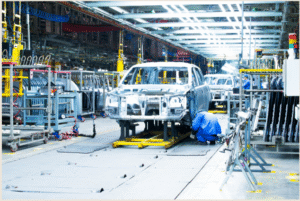Canada’s integrated automotive supply chain is currently under siege. What began as a tit‑for‑tat trade tussle between the U.S. and Canada has quietly spiraled into factory shutdowns, job losses, and diminished working hours in parts manufacturing plants—raising concerns about the long-term viability of Canada’s manufacturing prowess.

Tariffs Unleashed: The Flashpoint
In April 2025, the U.S. slapped a 25 % tariff on Canadian‑ and Mexican‑made vehicles and auto‑parts, citing national‑security concerns—though exempting USMCA‑compliant goods for a month Canada retaliated shortly after, imposing 25 % tariffs on U.S. vehicles, but notably not on auto parts—recognizing the deep
cross‑border interdependence.
Why Parts‑Makers Are Suffering
Every car moves across the border multiple times during production.
One parts supplier noted: modern vehicles contain ~30,000 parts, crossing
the Canada–U.S. border up to eight times, each movement incurring the tariff.

The resulting cost increases—often passed on to consumers—have begun
to erode factory output and labor hours. Just as U.S. motor‑vehicle production
dropped 2.6% in June, Canada’s parts sector is following suit. In March, Canada shed 33,000 jobs, led by full‑time manufacturing losses in Ontario and Alberta. Many layoffs were directly tied to auto‑parts plants halting production amid tariff uncertainty.
A Blueprint for Disruption
Companies like Stellantis have paused plants—Windsor, ON, saw a two‑week shutdown affecting 3,000 workers—as tariffs interrupted the flow of parts. Experts warn the auto ecosystem can only “tolerate these tariffs for a few weeks” before true collapse—predicting job losses, bankruptcies, plant closures and rising consumer prices. An advisory firm forecasts a 1.8 million drop in North American vehicle sales this year alone, with persistent tariffs pushing that figure to 7 million over the next decade.
Broader Ripple Effects
With auto‑parts factories cutting hours and laying off workers, local economies—particularly in Southern Ontario’s “Auto Belt”—are already feeling the strain. Canada’s broader manufacturing GDP (10%) and trade (23%) remain vulnerable; disruptions in the auto‑supply chain could trigger stagnation in growth. Consumers may soon face steep price hikes as manufacturers transfer tariff costs, squeezing vehicle affordability in a market already seeing average prices near $50,000.
Policy Moves and Industry Responses
The Canadian government has responded with partial measures: a C$2 billion strategic fund, tariff exemptions for parts, and mechanisms to support affected workers. Steel tariffs are another front: Canada imposed a 50 % “tariff‑rate quota” on over‑quota steel—and committed C$1 billion toward industry modernization. Meanwhile, Ford (with 80 % U.S.-built supply chains) prepared for cushioning the impact, but still forecasted drops in profitability and looming consumer-cost consequences.

What’s Next?
January‑2026 sees the USMCA review, which could ease—or extend—tariff-related consequences. The key risk: if tariffs persist, Canadian parts facilities may close or be relocated to U.S. plants, weakening Canada’s strategic manufacturing base. Canada is pushing for negotiations over its tariff exemptions for parts, aiming to restore manufacturing stability—yet the clock is ticking. For business leaders, now is the time to diversify supply chains, invest in automation, and lobby for more predictable trade policies.
Final Take
The cross‑border auto supply chain—Canada’s industrial backbone—is unraveling. Rising tariffs have triggered shorter work weeks, halted production, and mounting layoffs in parts plants. While both governments are scrambling to cushion the blow, the core issue remains: without a durable, USMCA‑anchored resolution, Canada risks long‑term damage to its vehicle‑parts manufacturing landscape. For industry leaders, the moment to act is now: adapt, advocate, and prepare for a future that’s more uncertain—and more urgent—than ever.

